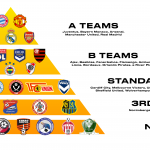
The piramid of adidas sponsorship
A Teams, B Teams, Standard, Third-Party e No Contract
November 3rd, 2020
The classification of the sponsorships of a brand is always interesting, especially to understand which clubs are given more weight and with what kind of approach a brand attacks a particular market. After Nike's sponsorship pyramid, Footy Headlines has rebuilt that of adidas. Apparently the structure may look similar, but the three stripes strategies are very different from those practiced by the swoosh. Before going into the details, the criteria on which this division of contracts between brands and clubs is based are 4: the official adidas catalogs, press releases, the strategies common to the main stores of the brand and the internal information that the specialized site has managed to get.
The adidas pyramid is made up of 5 categories: A Teams, B Teams, Standard, Third-Party and No Contract. The first substantial difference lies in the lowest step of the pyramid: no contract teams are the teams that adidas does not manage directly but is simply a supplier; while Nike works a lot with third parties to manage less important contracts, adidas tries to keep control internally on everything and uses little contacts that are not part of the company organization chart. Another point where the strategies of the brands differ is the transition from one category to another: on the one hand Nike remains rigid in its categorizations, on the other adidas considers the first two levels to be very fluid.
The top 5 clubs of the brand belong to the first band: Juventus (Serie A), Real Madrid (Liga), Bayern Munich (Bundesliga), Arsenal and Manchester United (Premier League). The attention paid to the best teams in terms of visibility and impact on the market is very high, as evidenced by the involvement of all the teams mentioned in the adidas x Humanrace project. Until last season, Flamengo also belonged to the first band, but in 2020 it was downgraded despite the South American market remains almost totally controlled by adidas.
Among the teams "B" are Ajax (Eredivise), Besiktas and Fenerbahce (Süper Lig), Flamengo (Brasileirão), Hamburg (Bundesliga), Lyon and Bordeaux (Ligue 1), Orlando Pirates (MLS) and River Plate (LPF). These teams - well distributed at a geo-football level - are entitled to customized ki models and a line of products designed ad hoc and for sale on the worldwide market.
In the middle of the pyramid are a dozen teams that fall into the "Standard" category. Under this name are teams such as Cardiff City (Championship), Melbourne Victory (A-League), Union Berlin (Bundesliga), Sheffield United, Wolverhampton, Fulham and Leicester City (Premier League). These clubs are the first to be excluded from the official adidas catalog and the kits made by the brand are for sale only and exclusively on a national market. According to the latest rumors, Leicester City and Union Berlin are the next candidates for promotion from "Standard" to "B-teams".
The "Third-Parties" represent the teams that do not have a direct contract with Adidas but with a third party that manages the contracts and works on behalf of the three stripes in certain markets. Many German teams such as Nuremberg, Düsseldorf, Unterhaching and all the teams of the minor leagues, including amateur and semi-professional realities, belong to this category.
Two categories not present in the pyramid deserve a special focus, but which have a great impact on adidas' balance sheet and brand awareness: MLS teams and national teams. The American professional football league has an exclusive contract with adidas and all 26 franchises have benefits that belong half to the B teams and half to the standard teams, therefore with customized kits and a dedicated line created ad hoc only for the teams that exceed certain sales volumes (such as the Los Angeles Galaxy).
As for the national teams, however, there is a sub-pyramid that divides the teams into Premium (Germany, Spain and Argentina) and Standard (Belgium, Sweden, Russia and Colombia).

The sponsorship pyramids of Nike and adidas are apparently similar but show different approaches: the use of third parties in the management of contracts, the structure of the categories itself, the chances of "going up in rank" and the difference in benefits and attention dedicated to club.























































